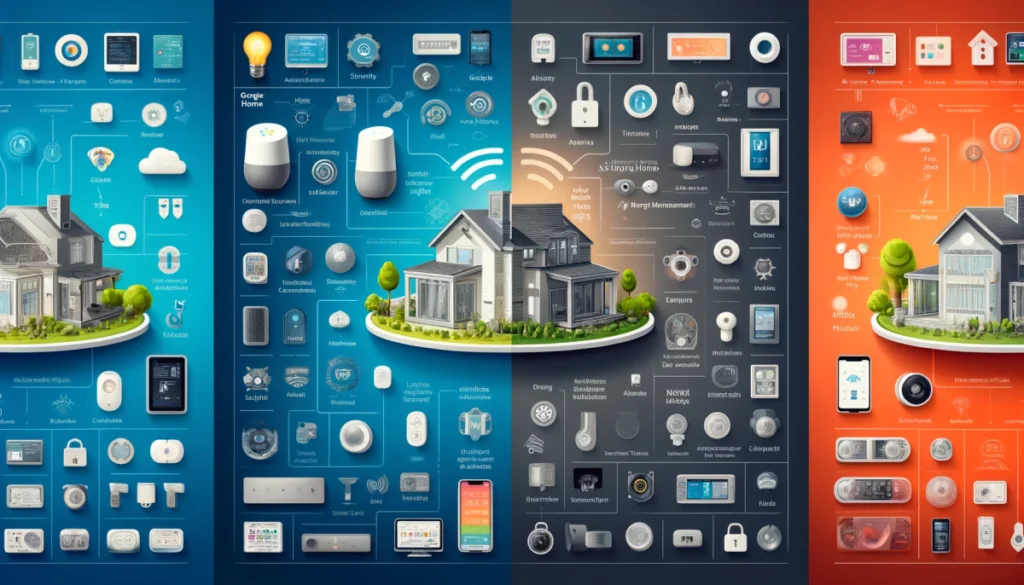Discover how to build a smart home in 2024 with our comprehensive guide. Learn the essentials of planning, selecting systems and devices, installing, and integrating innovative technology for enhanced comfort, security, and efficiency.
In 2024, turning your residence into a smart home represents an upgrade to your living conditions and a significant step towards energy efficiency and advanced home security. This guide will help beginners navigate the intricate world of intelligent technology, providing you with the knowledge and tools needed to implement a seamless digital transformation of your home. Whether your goal is to manage household devices from afar, enhance home security, or make your environment more comfortable, this guide will walk you through every step necessary to achieve a fully integrated smart home.
Table of Contents
How to Build a Smart Home Guide Overview
Building a smart home involves several critical steps to ensure your home automation is comprehensive and user-friendly. The process starts with a thorough plan and ends with the ongoing maintenance of yourHere’sligentwe’llems. Here’s what we’ll cover:
- Planning How to Build a Smart Home Layout
- Choosing the Right Smart Home Systems and Devices
- Installing and Setting Up Devices
- Integrating Systems for Seamless Control
- Maintaining and Upgrading Your Smart Home System
These steps will be elaborated on in detail, ensuring you have a robust framework to follow.
1. Planning How to Build a Smart Home
The first step in creating a smart home is planning. This phase is crucial as it sets the foundation for all subsequent actions.
Assessing Your Needs
Understanding what you need from a smart home is critical. Are you looking to enhance security and increase energy efficiency, or perhaps you are interested in the convenience of voice-controlled appliances? List your priorities and use these to guide your smart home features.
Mapping Out Your Home
Draft a floor plan of your home, noting potential locations for smart devices such as sensors, cameras, and speakers. Consider areas where you spend most of your time and entry points that would benefit from enhanced security.
Setting a Budget
Costs for smart home setups can vary dramatically based on the complexity and brand preferences. Set a preliminary budget, but be prepared for adjustments as you explore the variety of available devices and their capabilities.
Researching Products
With many smart home technologies available, research which products best meet your needs, are compatible, and fit your budget. Look for reviews, comparison articles, and user feedback to inform your decisions.
2. Choosing the Right How to Build a Smart Home Systems and Devices
The right ecosystem and compatible devices are crucial for a functional smart home setup.

Core Systems
Choose a core system like Google Home, Amazon Alexa, or Apple HomeKit. Each has its strengths and compatible devices, so select one that matches your needs and the devices you are interested in integrating.
Smart Devices
Investigate smart devices that work well with your chosen ecosystem. This includes items like smart thermostats, lights, locks, and cameras. Consider starting with essential areas like security or lighting before expanding to other smart home gadgets.
Security
Intelligent alarms, doorbell cameras, and windowhome’srs enhance your home’s security. Security is a top priority for many homeowners, and smart technology offers some of the best options today.
Energy Management
Smart thermostats and lighting can significantly reduce energy consumption, saving money and making your home greener.
3. Installing and Setting Up Devices
After choosing your devices, the next step is installing and configuring them to work together seamlessly.
Installation
Follow the manufacturer’s instructions carefully for each device. Consider hiring a professional for more complex setups, such as integrated security systems or intelligent wiring.
Network Security
Protect your smart home by securing your wireless network. Use strong passwords, enable encryption, and regularly equip your network equipment’s firmware to thwart potential cyber threats.
Device Configuration
Configure each device to suit your lifestyle. Set up custom scenes for lighting, schedule your thermostat, or automate your security system to arm at a particular time each day.
4. Integrating Systems for Seamless Control How to Build a Smart Home
Integration is critical to making your smart home system user-friendly and efficient.
Using a Central Hub
If your chosen ecosystem supports it, use a central hub to manage all your devices from a single point. This simplifies control and enhances device interoperability.
Creating Routines
Set up routines to automate daily tasks, like adjusting the thermostat at bedtime or turning on porch lights at sunset. This not only adds convenience but also enhances energy efficiency.
Voice Control
Implement voice control to make managing your smart home easier. This feature is handy for accessibility and multitasking.
5. Maintaining and Upgrading How to Build a Smart Home
Regular maintenance and occasional upgrades are necessary to keep your smart home at peak functionality.
Regular Updates
Ensure all devices run the latest software versions to maintain security and functionality. Set devices to update automatically where possible.
System Checks
Regularly test your systems to confirm that all components communicate correctly and function as intended.
Future Upgrades
Technology evolves rapidly, and staying current can bring significant benefits. Plan for future upgrades to incorporate new devices and features as they become available.
FAQ
- What is the best smart home system for beginners?
- It depends on your needs and tech comfort level. Still, Google Home, Amazon Alexa, and Apple HomeKit are excellent choices due to their broad device compatibility and user-friendly interfaces.
- How can I ensure my smart home is secure?
- Use strong, unique passwords for your devices and network, enable two-factor authentication, and keep software updated to protect against vulnerabilities.
- Can I install smart home devices myself?
- Many devices are designed for DIY installation, but some may require professional assistance, especially if they must be integrated into your home’s existing wiringWhat’sumbing systems.
What’s next?
Once your smart home is up and running, the possibilities for further enhancement are nearly limitless. Explore advanced automation features, consider expanding your system to include outdoor lighting and security, or integrate intelligent appliances like refrigerators and washers. Continuously monitor advancements in smart home technology to keep your system modern and efficient. Join online forums and subscribe to tech magazines to stay informed about the latest devices and features.
This detailed guide is your first step towards a fully functional smart home. Enjoy the process of upgrading your living space and the new level of convenience it brings.





